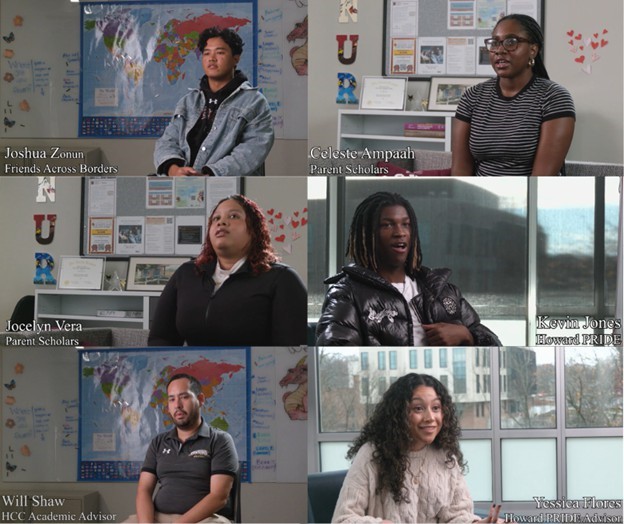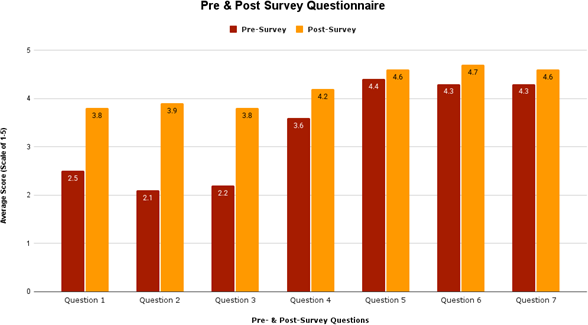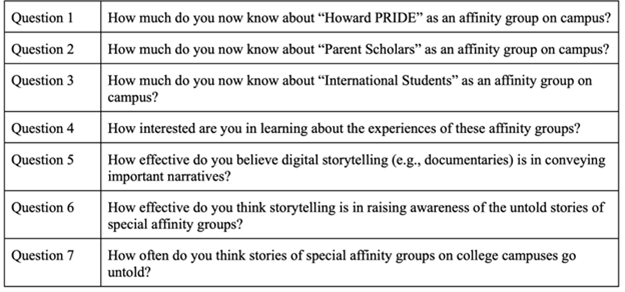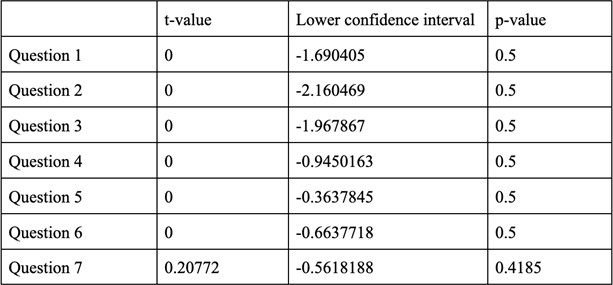|
The Impact of Digital Storytelling: Unveiling Untold Stories within a Diverse Community College Student Population Satya Kari, Howard Community College Mentored by: Cheryl Campo, Ph.D., J.D., and Bethany Pautrat, M.A. |
Abstract
Issues related to the untold stories of individuals’ experiences belonging to specific affinity groups can be prevalent in society and college communities. Our team chose to examine how digital storytelling can amplify the untold experiences of community college students from diverse affinity groups, aiming to bring awareness and representation to their often overlooked narratives. An in-depth literature review of peer-reviewed sources from the Howard Community College (HCC) library database revealed that many students experience discrimination based on factors tied to their respective affinity groups [1]. Sharing personal stories can illuminate these students’ experiences, challenge prevailing narratives, and represent various perspectives [2]. One effective method for sharing these stories is through documentary films, which can authentically capture individuals’ lived experiences, resulting in genuine and enlightening insights [3]. From the review findings, the team found an unmet need in the community to gather and share the often untold stories of community college students and advisors belonging to unique groups on our college’s campus. The effectiveness of digital storytelling was investigated through a combination of interviews, qualitative data collection, and a screening event to capture and share overlooked stories within HCC and the local community. The project’s impact was to raise awareness about the experiences of untold stories, strengthen connections across diverse groups within HCC and the local community, and provide a platform for individuals to share their lived experiences. Results from the surveys collected after the screening were positive. Participants reported a better understanding of the various affinity groups on campus and believed digital storytelling to be an effective medium in representing these groups and their real-life experiences.
Introduction
The Honors-in-Action Project (HIA), undertaken by the Alpha Alpha Sigma Chapter of Phi Theta Kappa (PTK), sought to understand how digital storytelling can be used to amplify the voices of underrepresented student communities from various cohorts at a community college.
The HIA project combines academic research into the PTK Honors Study Topic and community action to solve real-world challenges. Each year, PTK chapters are given a specific Study Topic that serves as the focus of the chapter’s HIA. Each new topic is developed by the Honors Program Council, Phi Theta Kappa’s very own “think tank”, which is composed of chapter advisors, consultants, and PTK staff. This year’s study topic was, “The Power of Stories,” which inspired our chapter to focus on the concept of untold stories—particularly those of underrepresented student groups whose lived experiences are often overlooked [4].
From this central idea of untold stories, our original research question emerged: How effective is digital storytelling in capturing and sharing these often unheard narratives within the local community? In other words, we sought to understand how digital storytelling could shed light on the lived experiences of students who may not typically have their stories heard, and whether shared storytelling could reveal common challenges across different student groups.
Digital storytelling refers to the use of computer-based tools to combine multimedia—such as graphics, audio, and video—with the art of personal storytelling [5]. For our project, we focused on three affinity groups at HCC: Howard PRIDE, which supports the academic and professional growth of minority male students; Parent Scholars, which assists low-income and/or student-parents in accessing resources to succeed; and Friends Across Borders, a mentorship program that pairs F1 visa students with current students to support cultural and academic adjustment [6, 7]. This method of media was chosen to make the student’s stories more personal and accessible.
Our literature review revealed that community college students often face discrimination based on factors tied to their affinity groups [1]. A qualitative study by Samanta highlighted the untold experiences of Asian and Asian American women in community colleges, reinforcing the lack of representation in traditional narratives [8]. Additional studies emphasized the power of storytelling methodologies in capturing personal experiences: Souza and Gupta argue that interviews are a vital medium for enabling marginalized voices to be heard, while Fitzgerald and Lowe assert that documentary filmmaking serves not only as an expressive tool but also as a valid research process [2, 3]. These findings affirmed the value of capturing lived experience authentically and informed our decision to use documentary film and qualitative interviews to amplify student voices at HCC.
The goal of our project was to investigate whether creating a platform for sharing untold stories could raise awareness and demonstrate the importance of representation. Our primary research questions focused on: 1) viewers’ feedback and reactions after viewing the untold stories from different affinity groups; 2) whether digital storytelling would bring awareness and representation to the experiences of students and faculty at community colleges; and 3) if digital storytelling is an effective way to unveil the untold stories and experiences of students and faculty associated with various affinity groups on our campus to the local community.
Based on our initial literature review, we developed the hypothesis that digital storytelling is an effective approach for increasing comfort, fostering open discussions about concerns, and unveiling the untold stories of diverse student affinity groups at HCC. This hypothesis aligns closely with our chosen theme of “Representation Through Stories”.
Methods and Materials
This research involved collaboration and multiple steps of implementation. We began by collaborating with Dr. Trent Haines, a psychology professor at Morgan State University, who provided videography resources and expertise. To identify participants for interviews, we held meetings with affinity group advisors on campus to select students willing to share their stories. Once the participants were selected, interviews took place in the HCC Honors Commons. This location was selected with the intent to conduct interviews in a comfortable academic setting that presented the least amount of obstacles for filming (lighting, acoustics, etc.).
PTK volunteers and Dr. Haines assisted in setting up the studio. After filming, we collaborated with Sasha DeBenedictis, an Honors student at HCC, to edit the footage into a 25-minute film. To evaluate the effectiveness of digital storytelling, we held two screenings advertised to all HCC students, inviting their families and friends through Canvas announcements, fliers passed around to students, and word-of-mouth. During the screenings, printed pre- and post-surveys were handed out to all viewers. These surveys were designed to gather feedback and reactions to determine whether digital storytelling effectively raises awareness and conveys important narratives to the viewers. After the screening, survey data was analyzed in Google Sheets with additional per-question t-tests performed in R 4.5.0.
Results
Central Themes of Interviews
Across interviews, students described feeling undervalued or misunderstood in their daily interactions with others. For instance, international students noted that others often assumed they could not speak English, while student-parents expressed concern that faculty might view them as taking advantage of available resources. Student-parents also reflected on being perceived as having easier lives than was actually the case, despite managing significant responsibilities outside school. International students also noted challenges in transitioning to a U.S. community college environment, including student status restrictions, visa-related job limitations, and lengthy commutes that contributed to academic and personal stress.
Despite personal challenges, students emphasized the value of community. Both students and advisors from Parent Scholars, Friends Across Borders, and Howard PRIDE described these programs as spaces where students felt seen, supported, and encouraged. They highlighted the role of an inclusive educational environment in helping students stay motivated and achieve their goals. One student described the strong sense of “brotherhood” that emerged within their cohort, underscoring the deep emotional support these programs provide. Friends Across Borders, a program serving international students, fosters connection through a peer mentoring system that pairs newer students with those more experienced in navigating the academic and cultural transition of entering an American college.
Students frequently described experiencing a heightened pressure to succeed academically, personally, and socially. For student-parents, this included balancing academic responsibilities with caregiving, while feeling a strong commitment to support their children’s future. A student affiliated with PRIDE reflected on the emotional weight of questioning whether they were doing “enough,” even while actively involved in campus life. This ongoing sense of striving was often linked to a strong sense of responsibility and a desire to meet both internal and external expectations.

Figure 1: Affinity group participants and advisors featured in interview segments of the documentary
Across all interviews, students consistently expressed positivity in the face of difficulty, which included systemic barriers, time constraints, and cultural transitions. Many expressed gratitude for the resources and relationships they had access to and saw their educational journey as an opportunity for personal growth. Their ability to remain optimistic and forward-focused, even under difficult circumstances, was a defining feature of their narratives and a powerful reflection of their perseverance.
Survey Findings
Among the eighteen participants who attended the screening and completed the pre- and post-surveys, all reported an increased understanding of the various affinity groups represented on campus. Each participant also expressed that digital storytelling was a powerful and meaningful method for capturing and conveying the real-life experiences of students and advisors from a range of backgrounds.
From pre- to post-survey, average scores for Questions 1–3, which focused on knowledge of the HCC affinity groups (Howard PRIDE, Parent Scholars, and Friends Across Borders), increased more sharply than those for Questions 4–7, which focused on participants’ impressions of digital storytelling as a medium. These trends suggest that the documentary had a stronger influence on increasing awareness of student groups than it did on shifting perceptions of digital storytelling itself.

Figure 2: Pre- and Post-Survey Questionnaire Data

Table 1: Pre- and Post-Survey Questions
Welch’s two-sample t-tests were performed on each pair of pre- and post-survey questions to evaluate changes in participants’ responses following the screening. Each t-test checked whether respondents’ scores improved (H1: μ2-μ1 > 0), where μ is the average score for each respective question. All tests were conducted using an 80% confidence interval. Although average scores increased across all seven questions, none of the comparisons reached statistical significance. The p-values for each test were at or above 0.4185.

Table 2: 80% t-tests on results of each question 𝐻1 > µ2 − µ1
Viewer comments further supported the survey findings:
“It’s extremely powerful. It makes a difference in understanding.”
“I think personal stories are emotional, motivational, and effective in sharing awareness of obstacles, barriers, and wants to encourage and increase success.”
“It’s a way to highlight individuals that might not get their story heard.” “Everyday people have stories to tell.”
“I am more conscious about what other people go through and not to judge on face value.”
“I love them 🙂 I think it makes you think more about the world around you, because people tend to get stuck in their own bubble.”
Discussion
Data Analysis
The data collected from our Honors in Action project revealed encouraging outcomes for the future use of digital storytelling in educational and community settings. Interviewees showed more comfort in opening up about their stories and experiences, possibly because of the intimate atmosphere of being interviewed by fellow students.
The most substantial increases occurred in Questions 1–3, which measured viewers’ knowledge of the three HCC cohorts. This suggests that the documentary was more effective at improving viewers’ understanding of the affinity groups themselves than it was at influencing their perceptions of digital storytelling as a method of increasing empathy and awareness (Questions 4–7). This may, in part, be due to participants already valuing storytelling prior to the screening or being less familiar with the specific student groups featured in the documentary.
Despite the change in averages, the t-tests could not conclusively verify the score increase. This outcome was not unexpected given the small sample size and use of convenience sampling. With only eighteen participants, the study may not have had enough statistical evidence to detect meaningful differences. However, the increase in average scores across all survey questions, paired with the overwhelmingly positive comments, suggests a promising trend.
Several factors may have influenced the statistical outcomes. The small sample size limited the strength of the analysis, and the convenience sampling method introduced the potential for bias. Furthermore, only nine individuals were interviewed for the documentary, and due to editing constraints, many hours of footage were not included in the final documentary video.
To strengthen future research, improvements could include increasing the sample size, incorporating random sampling techniques, and hosting additional screenings both on and off campus. These adjustments could allow for broader community engagement and provide a more representative understanding of the stories shared.
Connections to Literature Review
One prominent theme in student and advisor interviews was the feeling of being undervalued or misunderstood. International students shared that others often assumed they could not speak English or lacked academic preparation, while student-parents expressed concern that faculty might view them as taking unfair advantage of resources. The assumptions placed on affinity groups often masked the complex realities students faced, such as caregiving responsibilities, long commutes, or cultural transitions. The theme of being undervalued aligns with prior research on how underrepresented students manage misperceptions while balancing academic and personal demands [1]. Digital storytelling gave participants space to express these nuanced experiences on their own terms, challenging reductive assumptions and affirming their identities.
Another central finding was the importance of community and belonging. Students and advisors across all three affinity groups described their programs as more than academic support systems—they were safe, affirming spaces where individuals could connect with others who understood their experiences. Friends Across Borders facilitated meaningful peer mentorship among international students, Parent Scholars created a support network for caregiving students, and PRIDE fostered what one student described as a “brotherhood.” These descriptions reinforce Fitzgerald and Lowe’s framing of documentary storytelling as a process that not only documents experience but also strengthens social cohesion and community resilience [3].
Students also discussed an ongoing pressure to succeed academically, personally, and socially. For student-parents, this often meant striving to meet academic goals while also serving as role models and primary caregivers. Others expressed the emotional weight of questioning whether they were doing “enough,” even while highly engaged on campus. This pressure was frequently driven by a strong sense of responsibility and a desire to meet expectations, both internal and external. Storytelling in this context allowed students to reflect openly on these feelings and acknowledge their progress without minimizing their challenges.
Despite the obstacles described, nearly every student spoke with a sense of optimism and forward-thinking. Whether navigating immigration systems, financial strain, or time constraints, participants consistently expressed gratitude for the opportunities they had and the communities they belonged to. This aligns with research by Samanta, which suggests that marginalized students often draw strength from adversity and find meaning in educational pursuits as pathways to growth [8].
Taken together, these themes demonstrate how digital storytelling serves as both a reflective process and a meaningful catalyst for student voice. By sharing their lived experiences, students were able to engage more deeply with their identities, express challenges that are often unseen, and connect with others through shared understanding. While the quantitative findings were limited by sample size, the richness of the qualitative insights highlights the potential of digital storytelling to increase awareness, strengthen communication across diverse campus communities, and offer a meaningful way for students to speak to their experiences with honesty and clarity.
Conclusion and Future Work
This project demonstrated that digital storytelling is an impactful and accessible method for unveiling the untold stories of students and faculty from underrepresented affinity groups at HCC. While quantitative data was inconclusive due to sample size and sampling methods, the strong qualitative responses emphasized the emotional and educational value of the film.
By amplifying the voices of students who are often underrepresented, this project contributed to a more inclusive campus culture and provided a platform for meaningful conversations around identity and community. The results support the continued use and expansion of digital storytelling initiatives to foster empathy, promote understanding, and strengthen connections across diverse populations within the college and the broader community.
Future work could involve expanding the number of screenings to reach wider audiences, implementing a longitudinal survey design to capture change over time, and incorporating participant feedback directly into future productions. These enhancements would serve to strengthen both the storytelling process and the depth of its impact within and beyond the academic environment.
Acknowledgement
We would like to express our deepest gratitude to the Planning, Research and Organizational Development team for their invaluable guidance, patience, and encouragement throughout this research. We are especially thankful to Phi Theta Kappa for awarding us $1,000 through the Honors in Action grant, which provided vital financial support for the development and execution of this project. We also extend our sincere thanks to our advisors, Dr. Cheryl Campo and Ms. Bethany Pautrat; to Dr. Trent Haines, whose expertise and time were instrumental in guiding the film production; and to Sasha DeBenedictis for his thoughtful and timely editing. Lastly, we thank the entire Alpha Alpha Sigma Chapter leadership team for their dedication and collaborative effort in this research project.
Contact: ptk@howardcc.edu, lhamam@howardcc.edu, cnazaire@howardcc.edu, nikki.kreizel@howardcc.edu, satya.kari@howardcc.edu, liza.pon@howardcc.edu, dojin.lee@howardcc.edu, stephanie.simpson@howardcc.edu, isaac.schofer@howardcc.edu, bpautrat@howardcc.edu, ccampo@howardcc.edu
References
[1] C. Mahoney, B. J. Becerra, D. Arias, J. E. Romano, and M. B. Becerra, “‘We’ve Always Been Kind of Kicked to the Curb’: A Mixed-Methods Assessment of Discrimination Experiences among College Students,” International Journal of Environmental Research and Public Health, vol. 19, no. 15, p. 9607, Aug. 2022, doi: https://doi.org/10.3390/ijerph19159607.
[2] P. de Souza and S. Gupta, “14. Why Stories Matter for Representation, Action, and Collectivization,” Feminist Futures of Work, pp. 197–206, Dec. 2023, doi: https://doi.org/10.1515/9789048556892-017.
[3] Fitzgerald and M. Lowe, “Acknowledging Documentary Filmmaking as not Only an Output but a Research Process: A Case for Quality Research Practice,” International Journal of Qualitative Methods, vol. 19, p. 160940692095746, Jan. 2020, doi: https://doi.org/10.1177/1609406920957462.
[4] “Five Star Chapter Plan,” Phi Theta Kappa, Aug. 15, 2024. https://www.ptk.org/five-star-chapter-plan/ (accessed 25, 2025).
[5] “Educational Uses of Digital Storytelling,” edu, 2019. https://digitalstorytelling.coe.uh.edu/page.cfm?id=27&cid=27
[6] C. College, “Parent Scholars Program | Howard Community College,” Howardcc.edu, 2024. https://www.howardcc.edu/services–support/academic-support/academic-support-programs/parent-scholars-program/ (accessed Mar. 25, 2025).
[7] C. College, “You Are Welcome Here | Howard Community College,” Howardcc.edu, 2021. https://www.howardcc.edu/about-us/news–press/news/you-are-welcome-here/ (accessed Mar. 25, 2025).
[8] Samanta, “The American Community College as ‘Stepping Stone’: Opportunity, Agency, and Family in Asian and Asian American Women’s Educational Histories,” Journal of Asian American Studies, vol. 21, no. 3, pp. 367–393, 2018, doi: https://doi.org/10.1353/jaas.2018.0024.
[9] W. Cheah, K. Y. Koay, and K. Xiang, “Uncovering the Voices of Marginalized Minorities in Public Policy Research – A Critical Review of the Image and Text-Based Vignette Method,” International Journal of Qualitative Methods, vol. 22, p. 160940692311634, Jan. 2023, doi: https://doi.org/10.1177/16094069231163429.
[10] KC, “The untold stories of resilience, reworking and resistance of ageing non-European migrant women,” European Journal of Social Work, pp. 1–12, Jul. 2024, doi: https://doi.org/10.1080/13691457.2024.2368255.
[11] Robinson, “From the president’s desk: #EndCCStigma: Social media as a tool to change public perception of 2‐year colleges,” New Directions for Community Colleges, vol. 2022, no. 197, pp. 141–155, Dec. 2021, doi: https://doi.org/10.1002/cc.20503.
